ROM/MMT: Shoulder/ Scapula
1/29
There's no tags or description
Looks like no tags are added yet.
Name | Mastery | Learn | Test | Matching | Spaced |
|---|
No study sessions yet.
30 Terms
Must say:
1. Say AROM measurement
2. say PROM measurement
3. say assessment of PROM (normal, hyper/hypo mobile)
4. End Feel (based off PROM) and say if it's normal
ROM: Shoulder Complex- Shoulder Flexion
Testing Position: supine with knees flexed (flatten spine), shoulder by side, elbow extended, forearm neutral (palm face body)
Stabilize: thorax (prevent extnesion of spine and rib movement) and distal radioulnar
Motion: lift humerus off table, over head
Goni:
- Fulcrum: lateral aspect of greater tubercle
- Proximal arm: parallel to midline of thorax
- Distal arm: lateral midline of humerus (lateral epicondyle or olecranon)
Normal: 180
End feel: firm
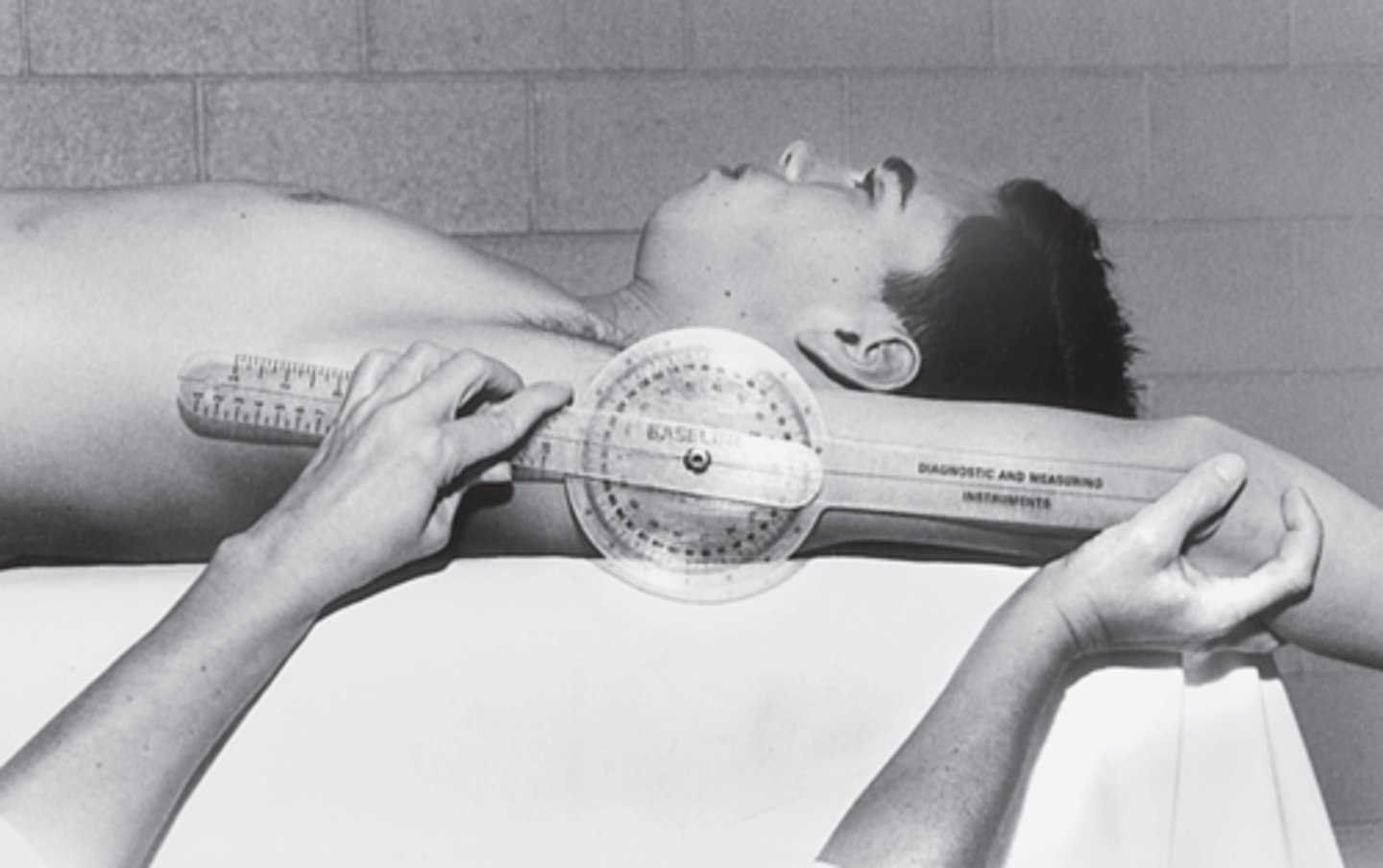
ROM: Shoulder Complex- Shoulder Extension
Testing Position: prone w/ no pillow, hand by side, elbow in slight flexion, forearm in neutral
Stabilize: trunk (prevent rotation of spine)
Motion: lift humerus off table
Goni:
- Fulcrum: lateral aspect of greater tubercle
- Proximal arm: midaxillary line of thorax
- Distal arm: lateral midline of humerus (lateral epicondyle)
Normal: 60
End feel: firm (tension in SC capusule/ligaments + serratus anterior muscle)
End feel: firm
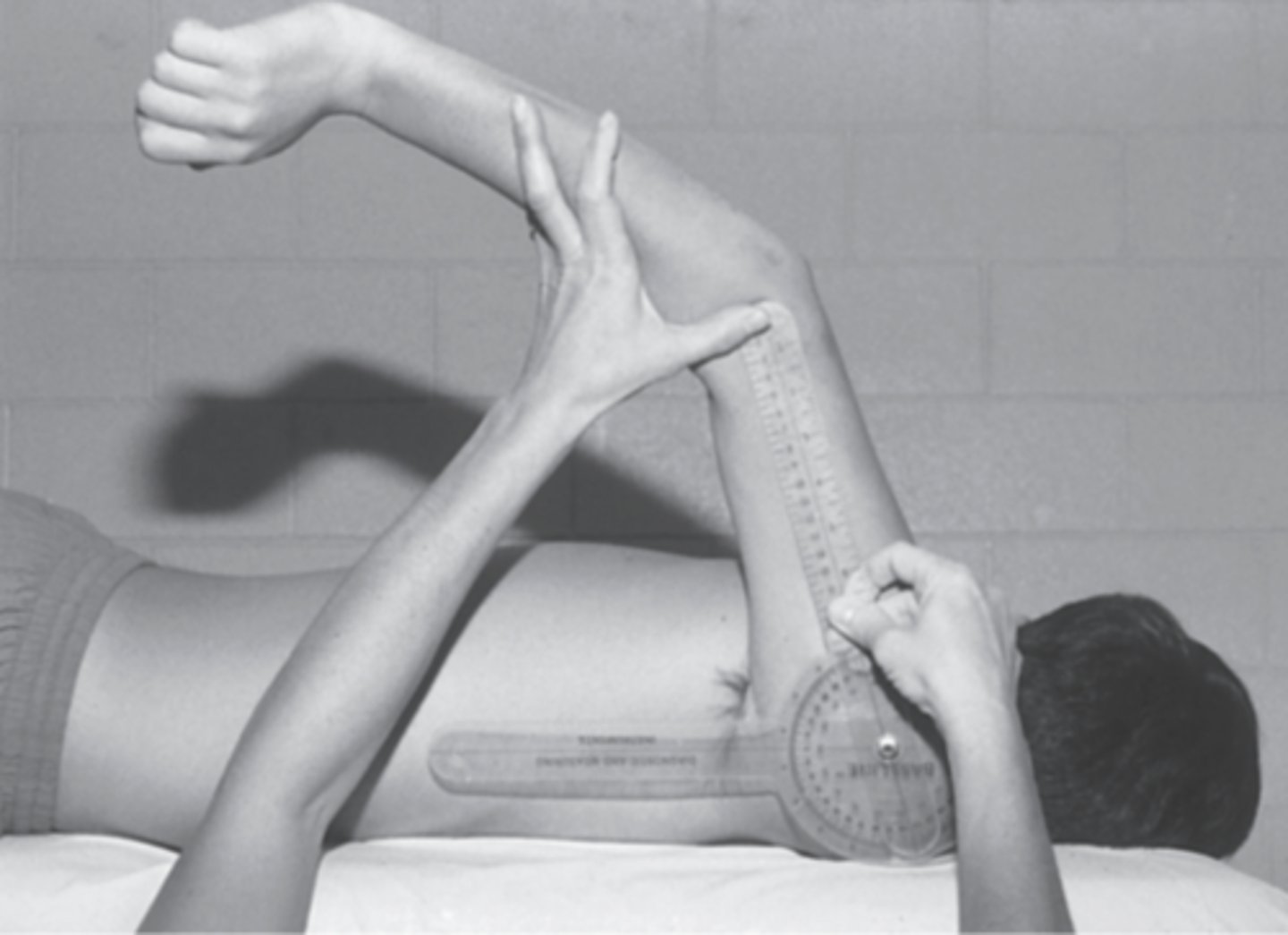
ROM: Shoulder Complex Shoulder Abduction
Testing Position: supine, palms face up, elbow extended
Stabilize: thorax (prevent lateral flexion of spine)
Motion: abduct shoulder by moving humerus laterally away from trunk
Goni:
- Fulcrum: olecranon process
- Proximal arm: perpendicular/parallel to floor
- Distal arm: ulna (olecranon process + ulnar styloid)
Normal: 180
End feel: firm (tension in SC capusle/ligament, CC ligament, and rhomboids m/M + trap)
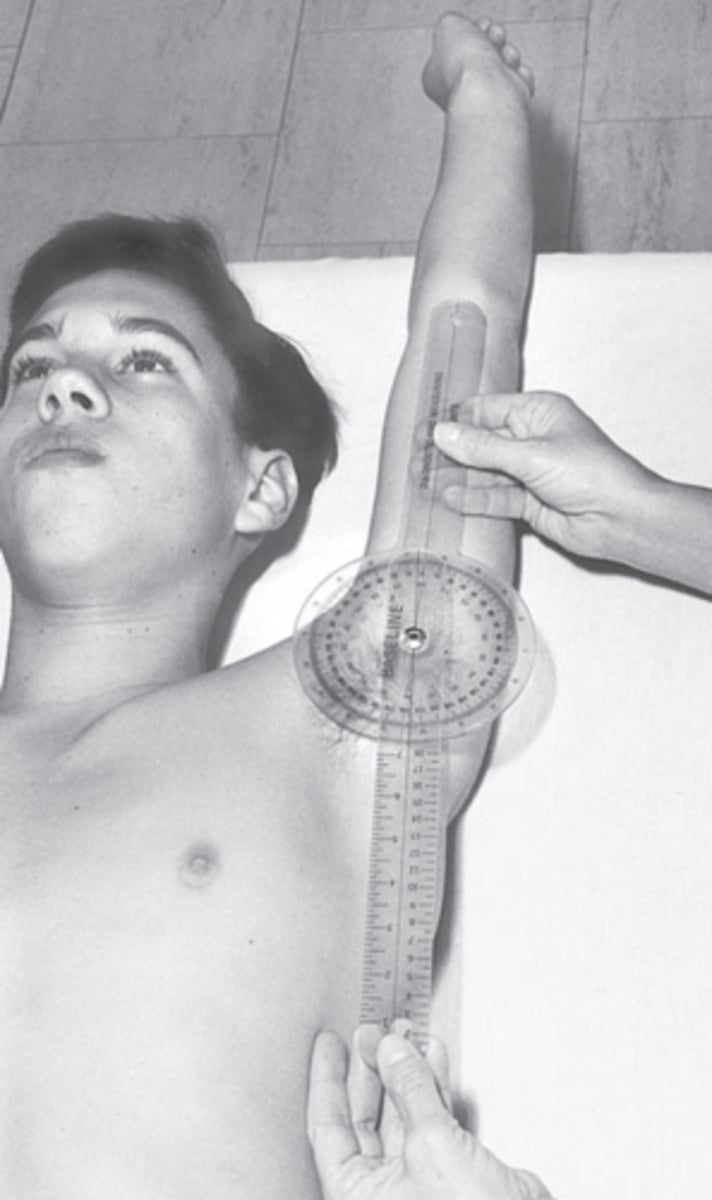
ROM: Shoulder Complex Internal Rotation
(Transv pl/vertical ax)
Testing Position: supine, arm 90 degree, place forearm in perpendicular to supporting surface, humerus on table with towel supporting, elbow off table
Stabilize: start at distal end of humerus + wrist, thorax
Goni: (start together)
- Fulcrum: olecranon process
- Proximal arm: perpendicular to floor
- Distal arm: along ulna, olecranon + styloid as reference
Normal: 70-90?
End feel: firm (tension in posterior joint capusule, teres m, infra)
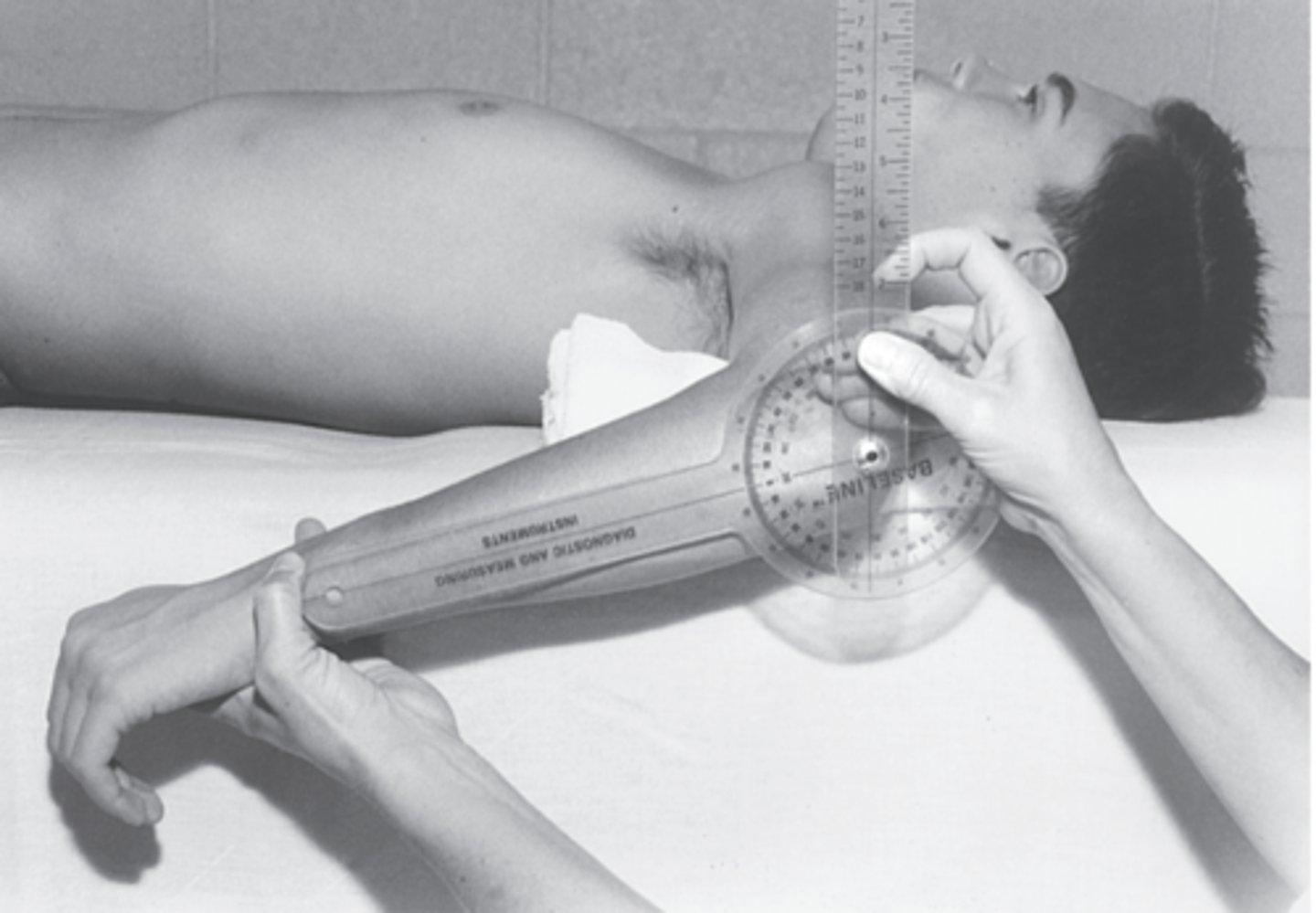
ROM: Shoulder Complex- Shoulder External Rotation
(transv pl/vertical ax)
Testing Position: supine, arm 90 degree, place forearm in perpendicular to supporting surface, humerus on table with towel supporting, elbow off table
Stabilize: start at distal end of humerus + wrist, thorax
Goni: (start together)
- Fulcrum: olecranon process
- Proximal arm: perpendicular to floor
- Distal arm: along ulna, olecranon + styloid as reference
Normal: 0-90
End feel: firm
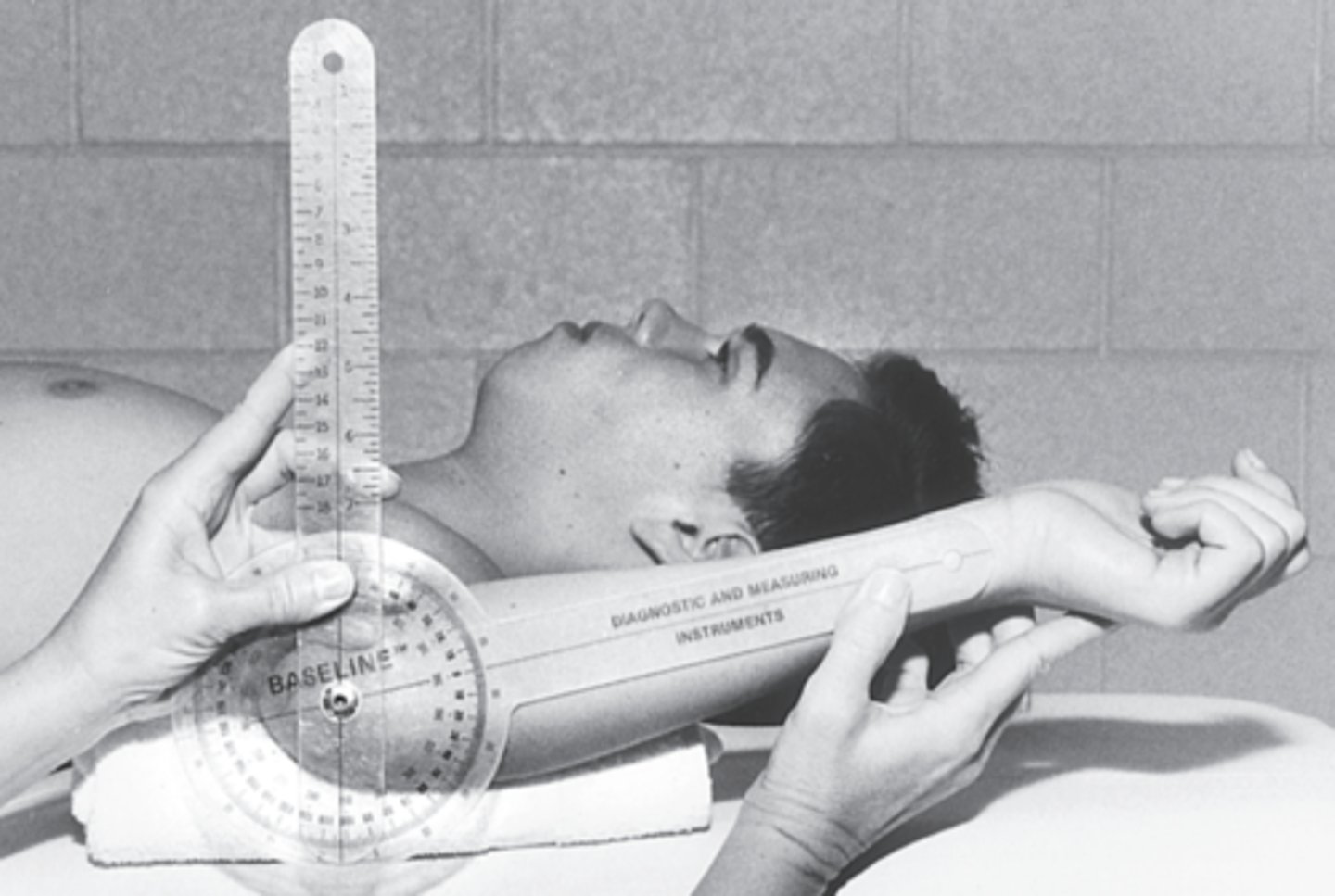
Muscle Length Biceps Brachii
Supine: arm off edge of table, flex elbow, full shoulder extension, pronate hand, extend elbow
Stabilize: shoulder and distal end of wrist
End Feel: firm
Test bicep length if tricep extension is bad
(If limited 40 degrees short of 0,
If muscle tight, there should be less ROM)
- "Biceps muscle length test is 40 degrees short of extension"
If the biceps brachii is short, it limits elbow extension
when the shoulder is positioned in full extension and
the forearm is in full pronation. If elbow extension is
limited regardless of shoulder and forearm position,
the limitation is due to abnormalities
Muscle Length: Triceps Long Head
Testing Position: supine, supinate forarm,
flex shoulder all the way (arm above head), flex elbow
Stabilize:
posterior mid humerus and anterior mid/distal forearm
Goni:
- Fulcrum: lateral epicondyle of humerus
- Proximal arm: lateral midline of humerus (acromion process)
- Distal arm: lateral midline of radius (radial styloid process)
Normal: ??
End feel: firm (tension in long head of tricep)
MMT: Shoulder flexion
anterior deltoid
Position: sitting arms at sides, foot supported, hand pronated
Instruction: start at test side, pt raise arm foward to shoulder height (90), keep elbow straight, apply resistance on distal humerus
2/5: gravity minimized
3/5: full 90 rom w/out resistance
4/5: hold against strong/moderate resistance
5/5: hold against max resis
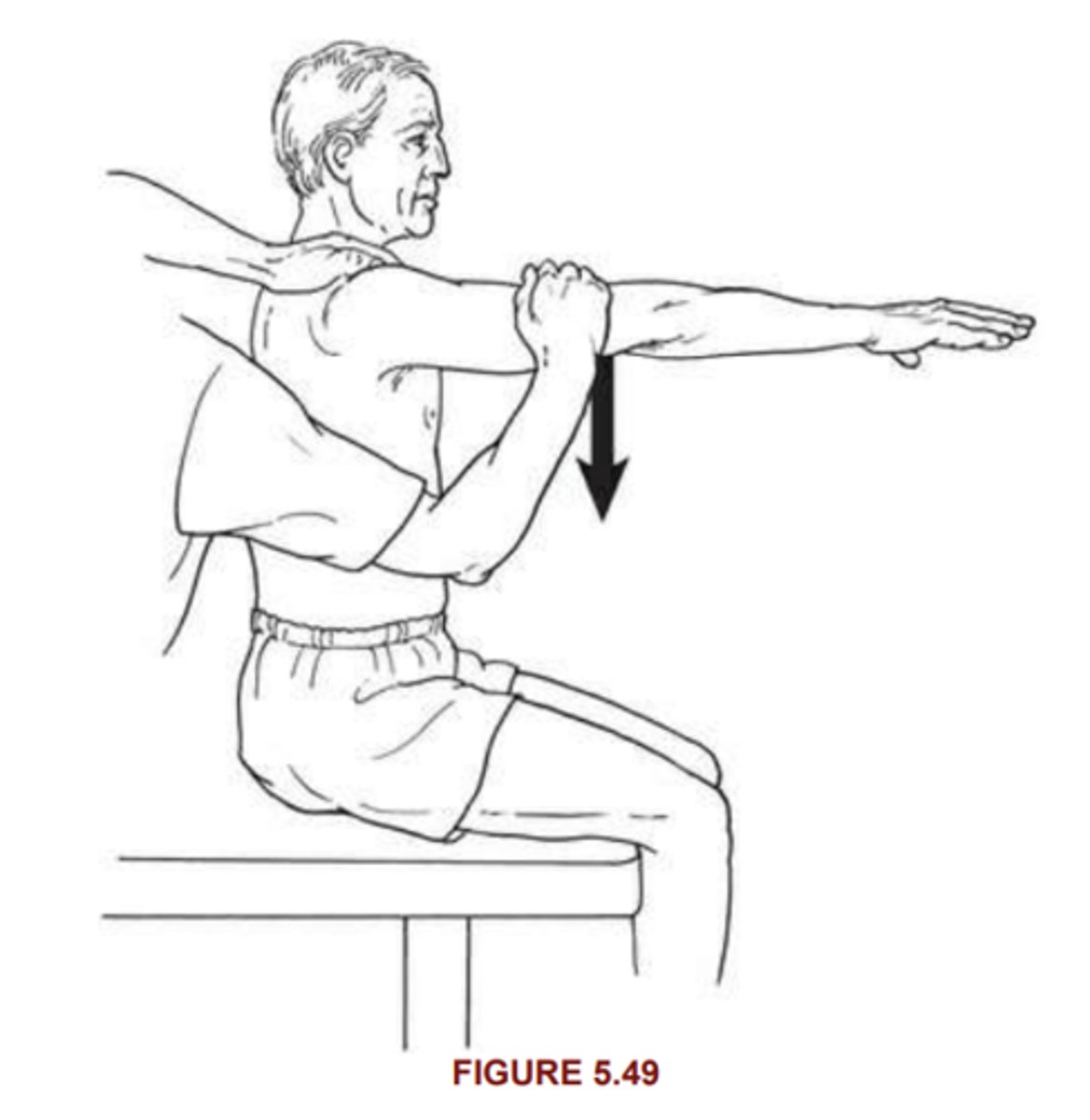
MMT: Gravity Resisted Shoulder Flexion
Instructions: patient side-lying to minimize gravity, stand behind patient, cradle test arm at elbow, ask to flex the shoulder
2/5: rull rom in minimized position
1/5: feel or see contractio of ant. deltoid, but no motion
0/5: no palpable contraction
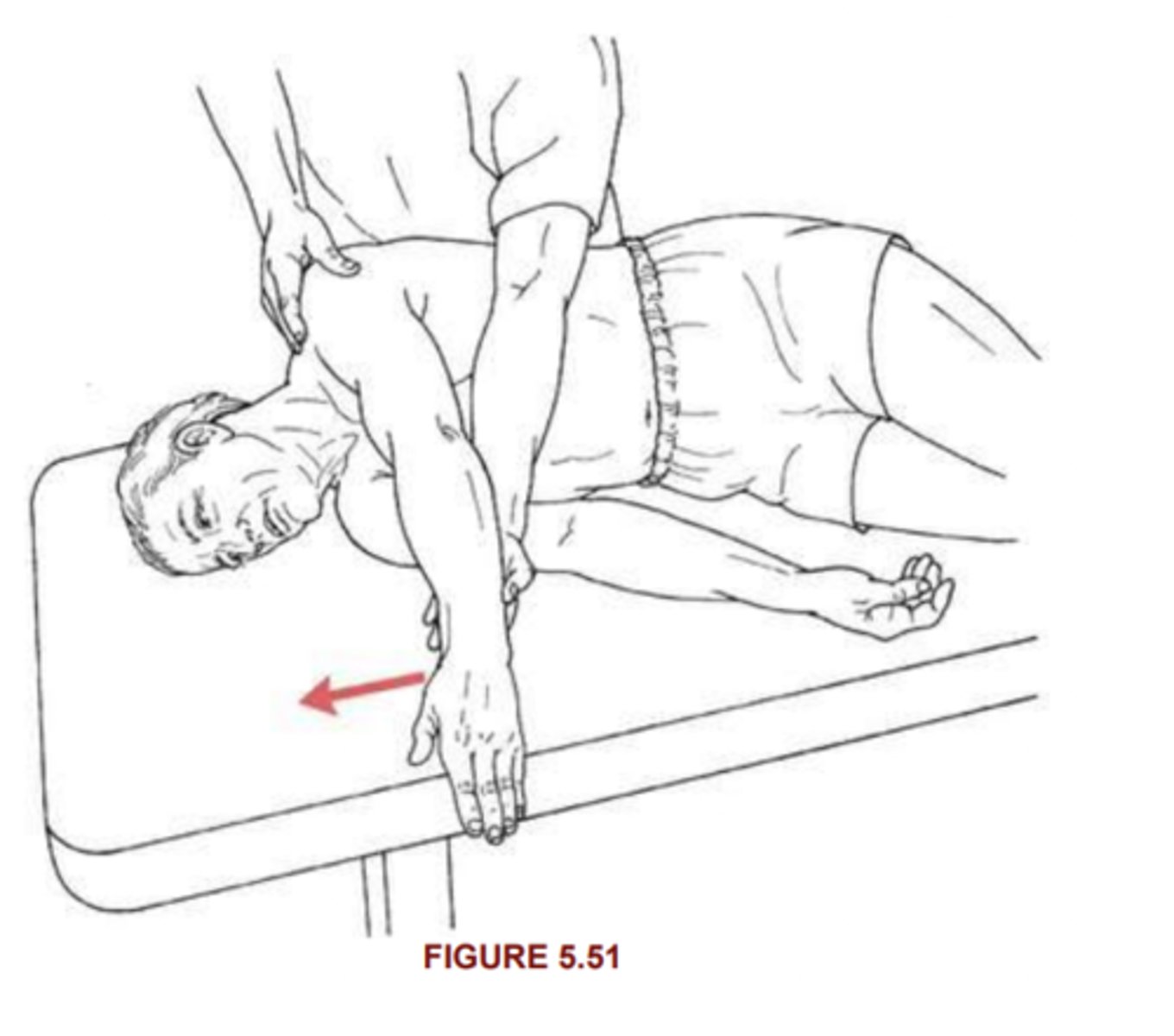
MMT: Shoulder Extension
-post delt, lat dorsi, teres M, LH triceps
Position: prone, arms at side, shoulders internally rotated for palms up
Instruction: stand at side, pt lift arm asap, position arm at end range, apply resistance distal humerus
2/5: partial rom
3/5: full 90 rom w/out resistance
4/5: hold against strong resis
5/5: hold against max resis
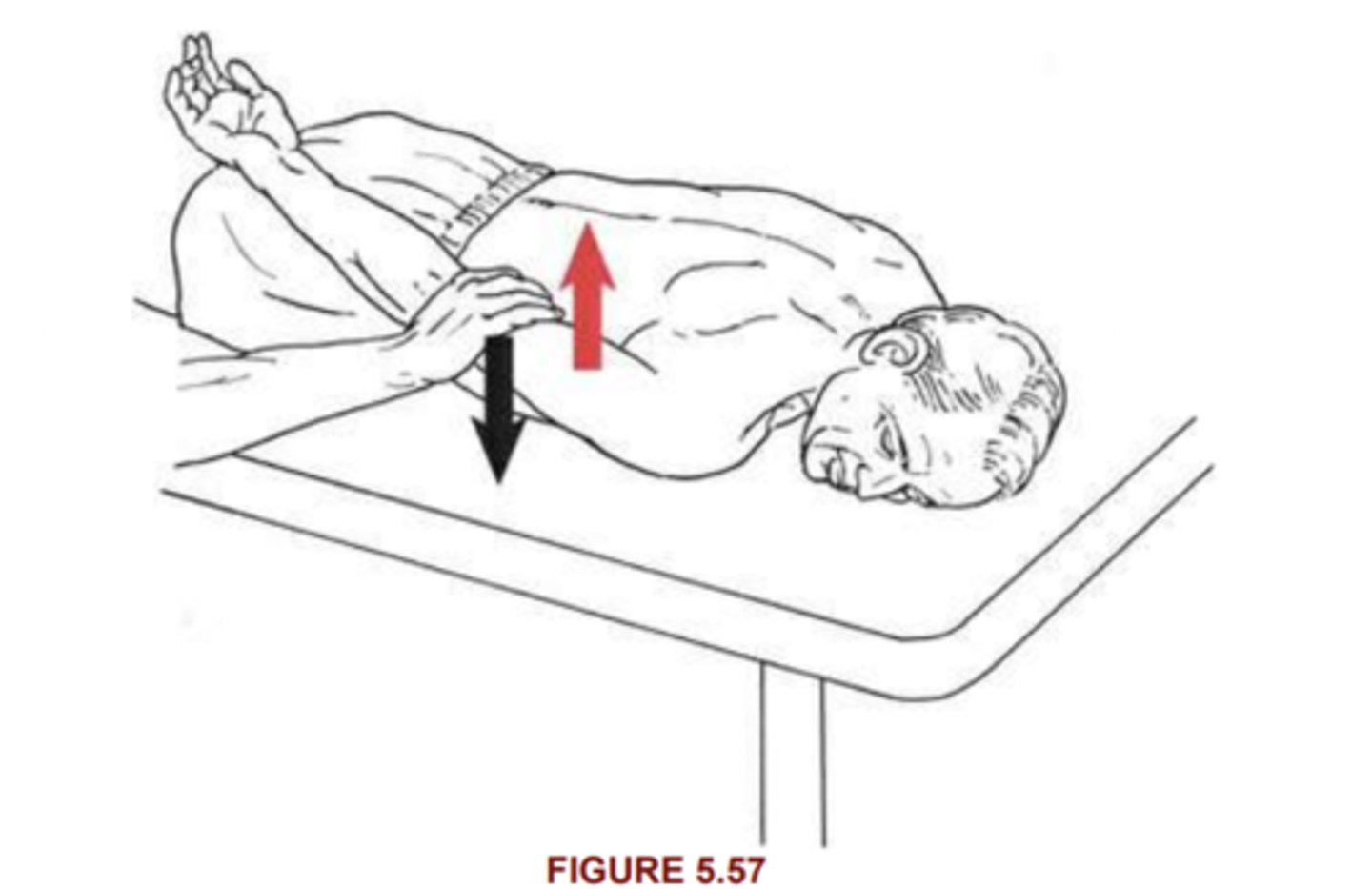
MMT: Gravity Minimized Shoulder Extension
palpate over post shoulder for post. deltoid fibers
pt try to lift arm off table
1/5: palpable contraction but no momement
0/5: no contraction
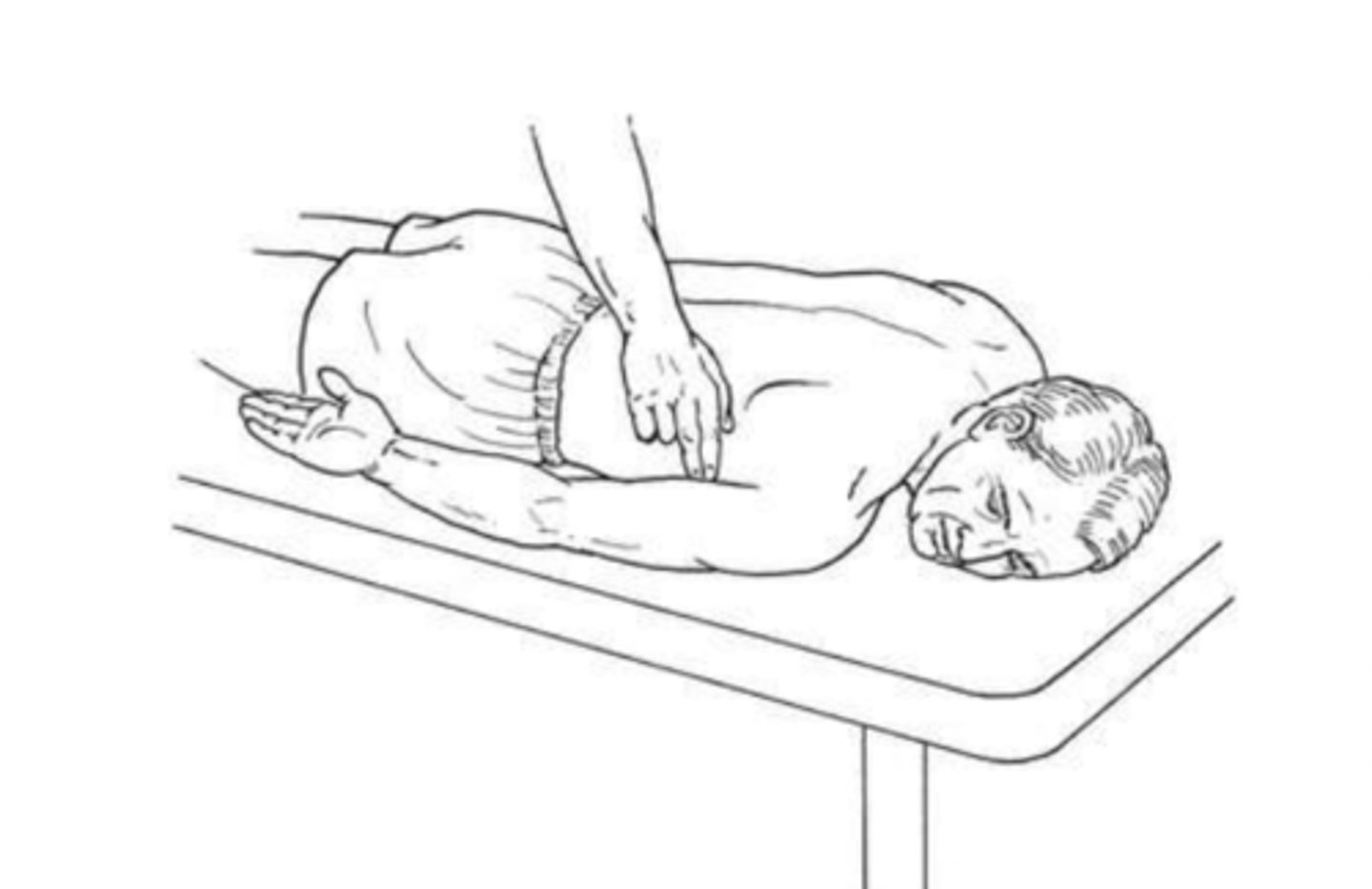
MMT: Shoulder Abduction??
-middle delt, supraspinatus
Position: prone, arms at side, shoulders internally rotated for palms up
Instruction: stand in FRONT, pt lift single arm to side, resist downward over distal humerus
2/5: partial rom
3/5: full 90 rom w/out resistance
4/5: hold against strong resistance
5/5: hold against max resis
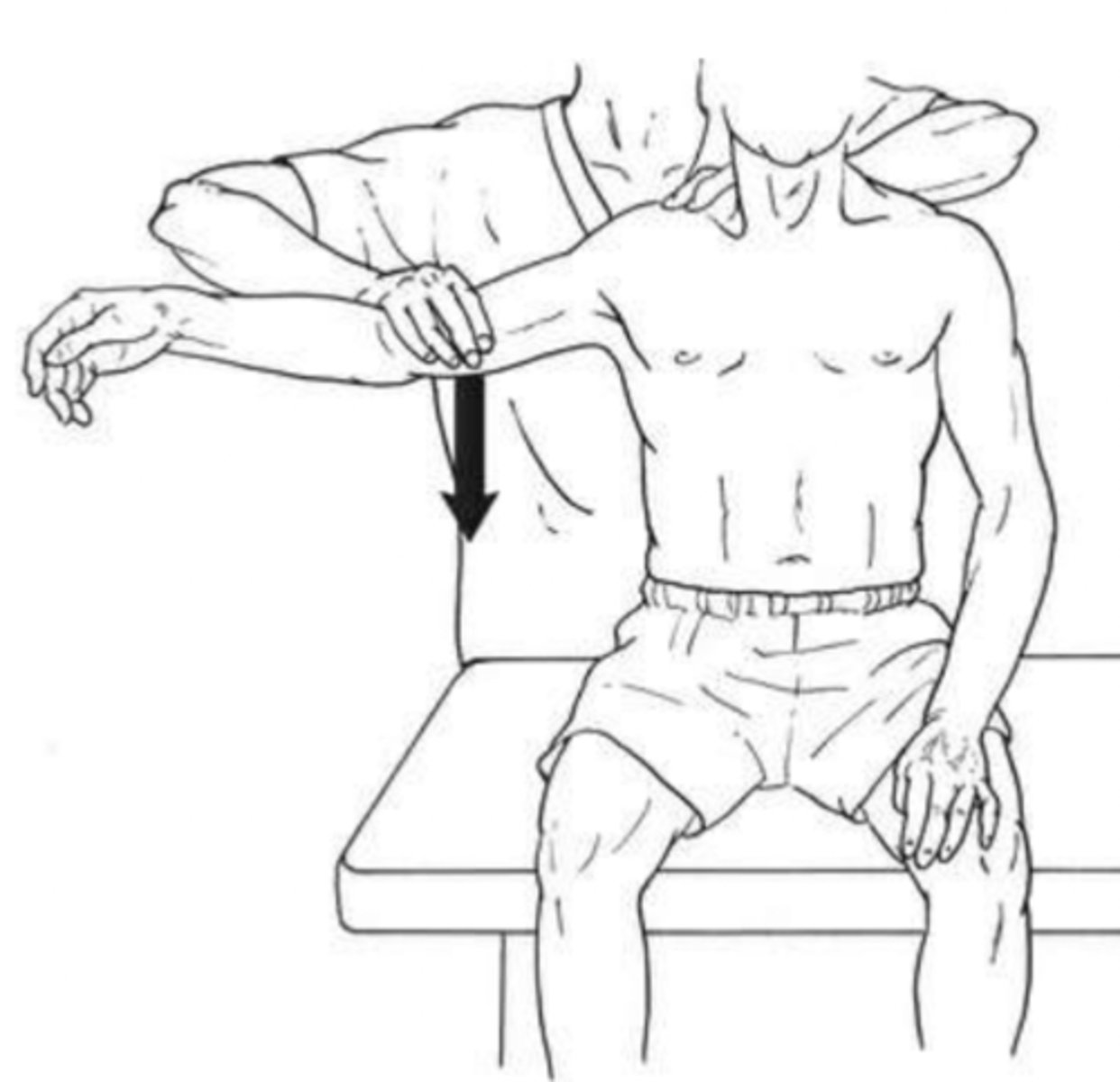
MMT: Gravity Minimized Shoulder Abduction??
Grade 2:
Completes full range of motion in this gravity-minimized position or cannot raise shoulder to 90 w/ elbow staight
1/5:
Palpable or visible contraction of deltoid with no movement
0/5:
No discernable palpable contractile activity
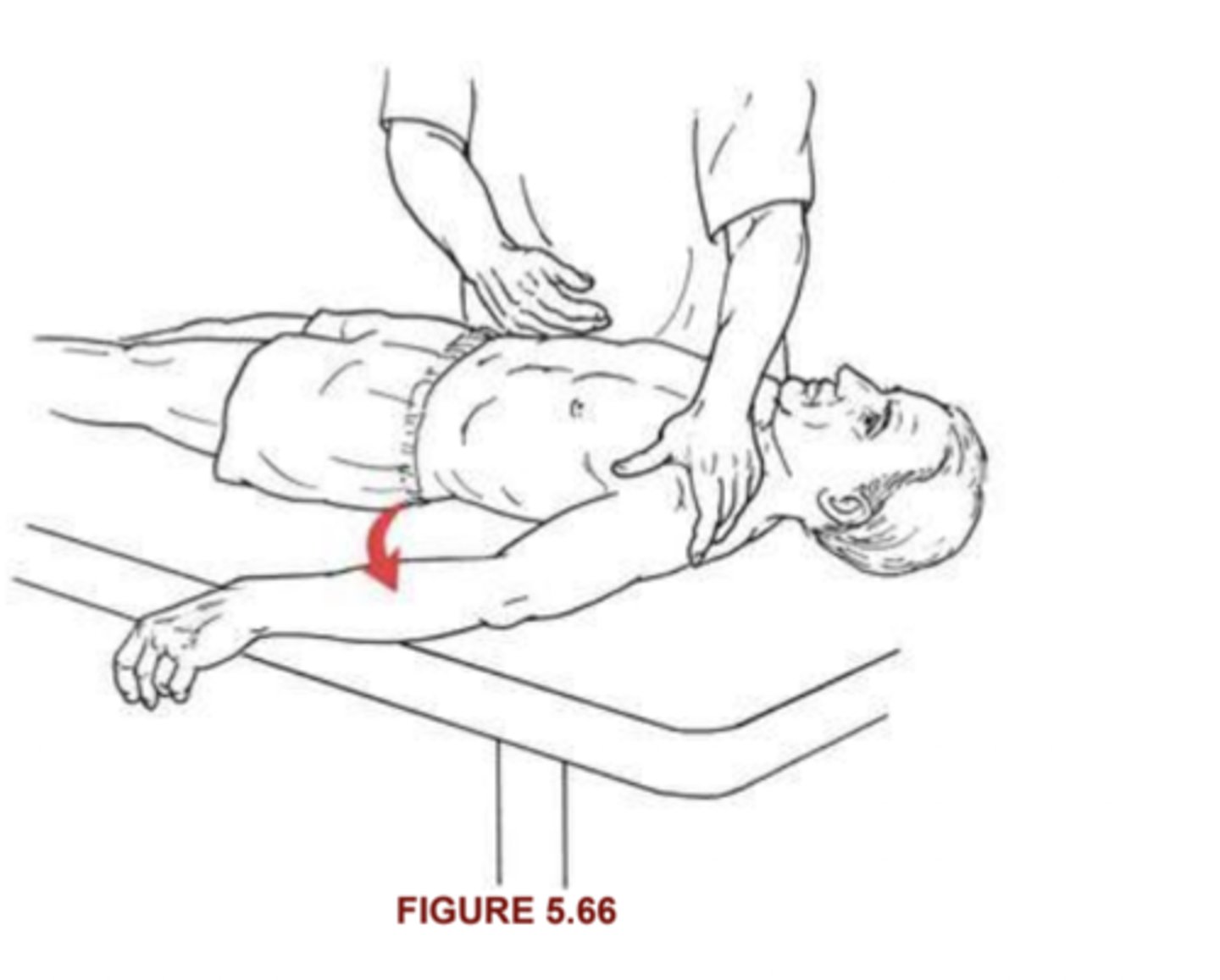
MMT: Shoulder Horizontal Abduction
-post delt
Position: prone, shoulder abd to 90, forearm off edge w/ straight elbow
Instruction: stand at side, ask to lift elbow to ceiling, resist over distal humerus, support trap
2/5: partial rom
3/5: full rom w/out resistance (elbow can be flexed)
4/5: hold against strong resistance w/ wobble
5/5: hold against max resis completely stable
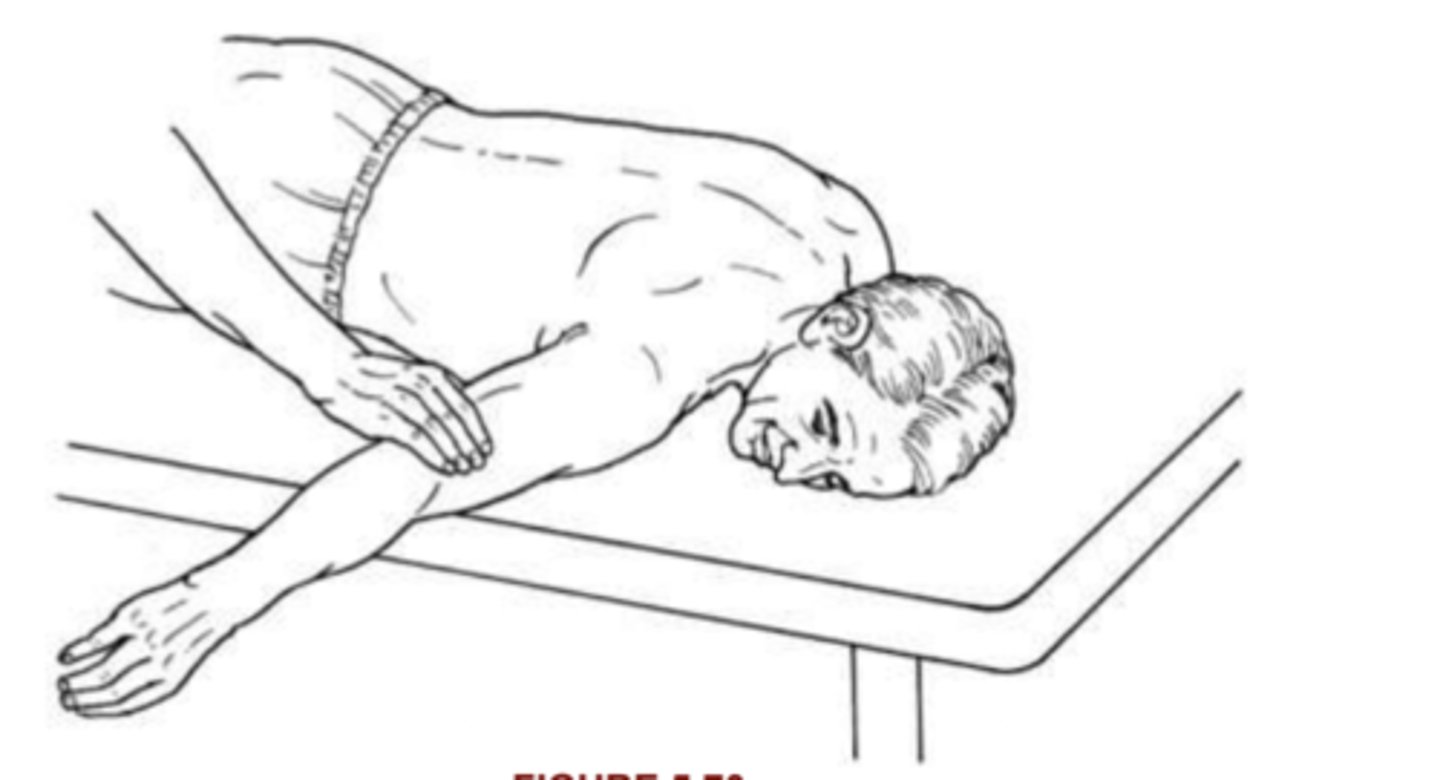
MMT: Gravity Minimized Shoulder Horizontal Abduction
Position: Short sitting with arm supported on table (smooth surface) in 90° of abduction; elbow partially
flexed.
Instructions:
Stand behind patient. Stabilize by contouring one hand over the superior aspect of the shoulder and
the other over the scapula
Test:
Patient slides (or tries to move) the arm across the table in horizontal abduction.
2/5:
Moves through full range of motion.
1/5
Palpable contraction; no motion.
0/5
No discernable palpable contractile activity.
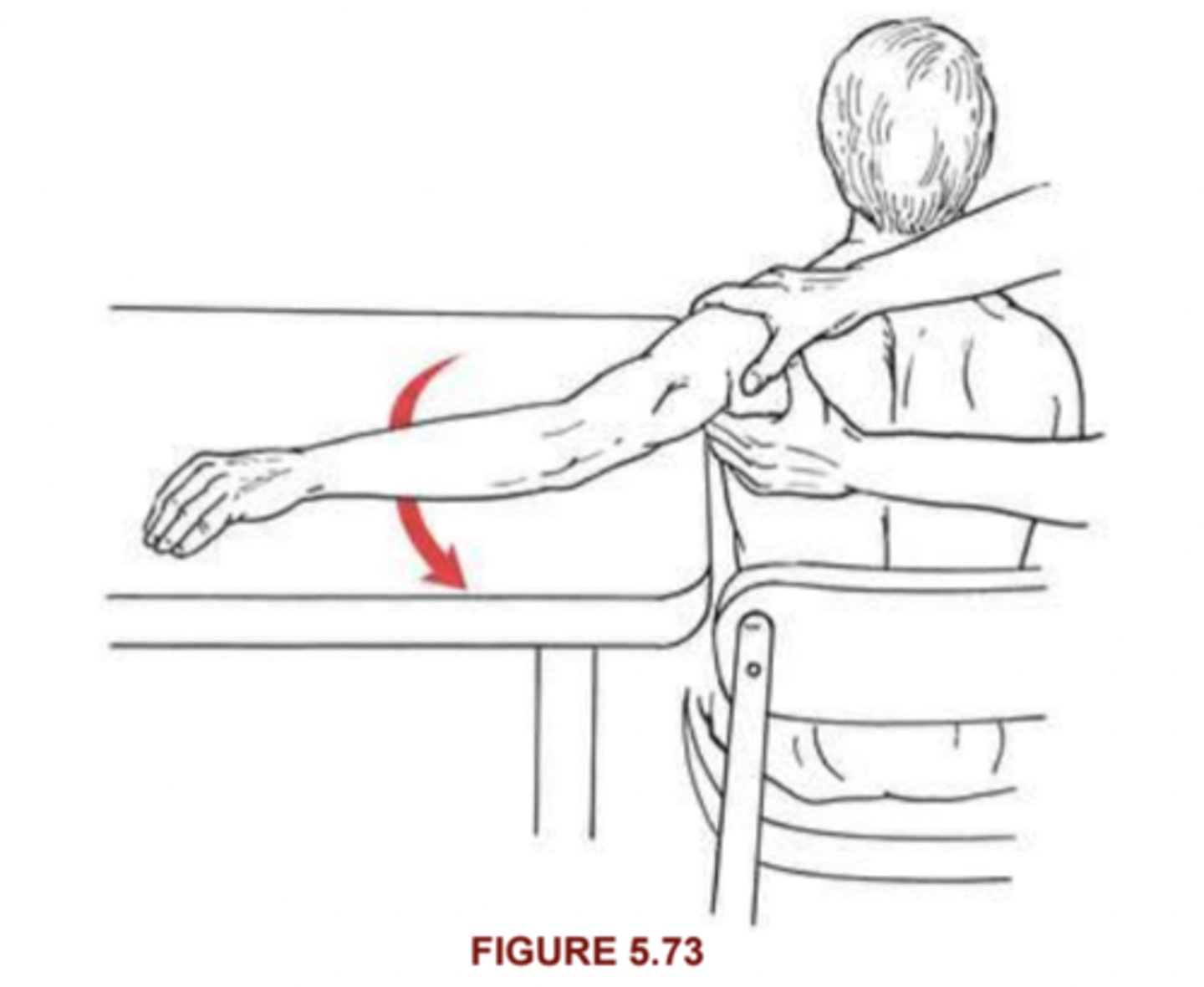
MMT: Shoulder Horizontal Adduction
pec major- upper (clavicular) lower (sternum)
-Position: Supine, shoulder abducted to 90, elbow flexed to 90 (transverse plane)
Instruction: (point hand in direction you're testing)
upper: toward opposite ear (diagonal)
lower: pointing downward to opposite hip (toward sternum)
together: move arms across chest
2/5: taking the weight of the arm
3/5: completes available rom in all 3, w/ no resis
4/5: holds position with strong/moderate resistance, muscle "give" at end rom
5/5: holds test position against max resis
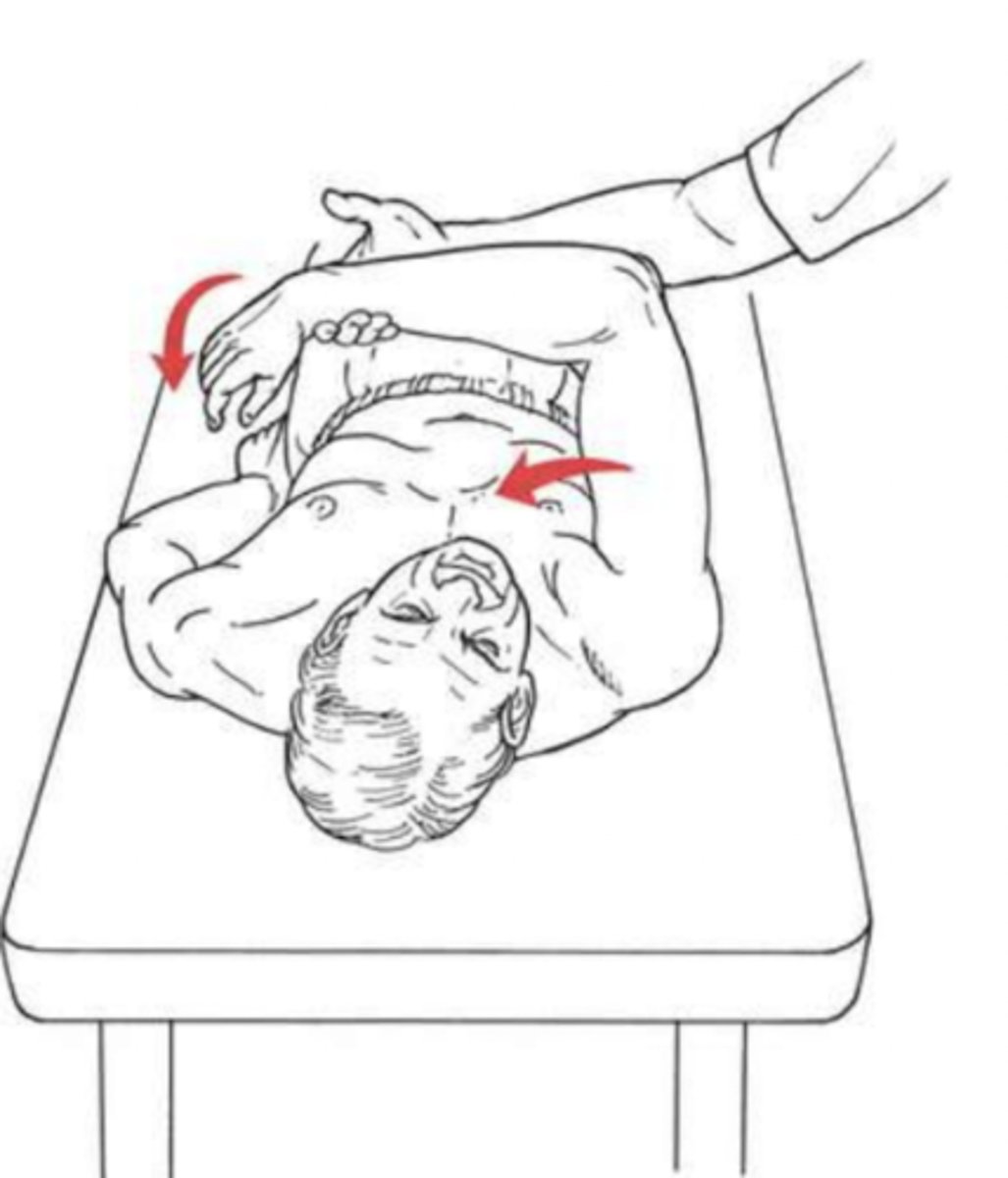
MMT: Gravity Minimized Shoulder Horizontal Adduction
Position: supine, arm supported in 90 abd with elbow flexed to 90
Instruction: support full lengtth of the forearm and hold limb at wrist
2/5: pt horizontally adducts shoulder through full rom with weight of arm supported by PT or table
1/5: palpable contractile activity
0/5: no palpable contractile activity
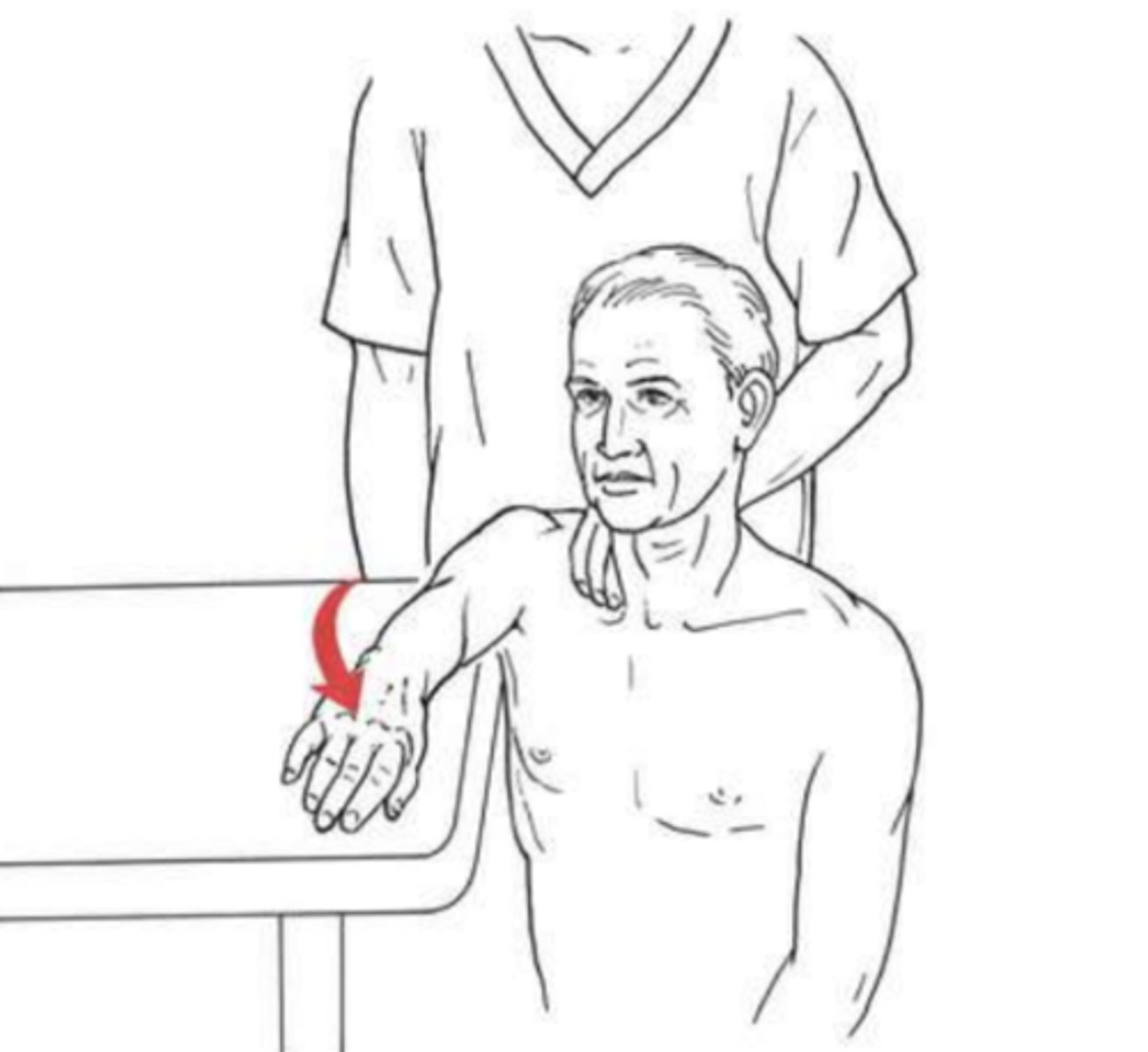
MMT: Shoulder External Rotation
Infraspinatus, teres minor, (supraspinatus, deltoid posterior)
Position: seated (for all grades), elbow flexed to 90, forearm netural, next to body
Instruction: stand in front of pt, ask to move forearm away from trunk, stabilize medial aspect of elbow and resist on extensor surface of forearm
3/5: full rom w/ no resis (ask for arom into full ER then bring arm back)
4/5: holds test position with some yield
5/5: holds test position against maximal resistance
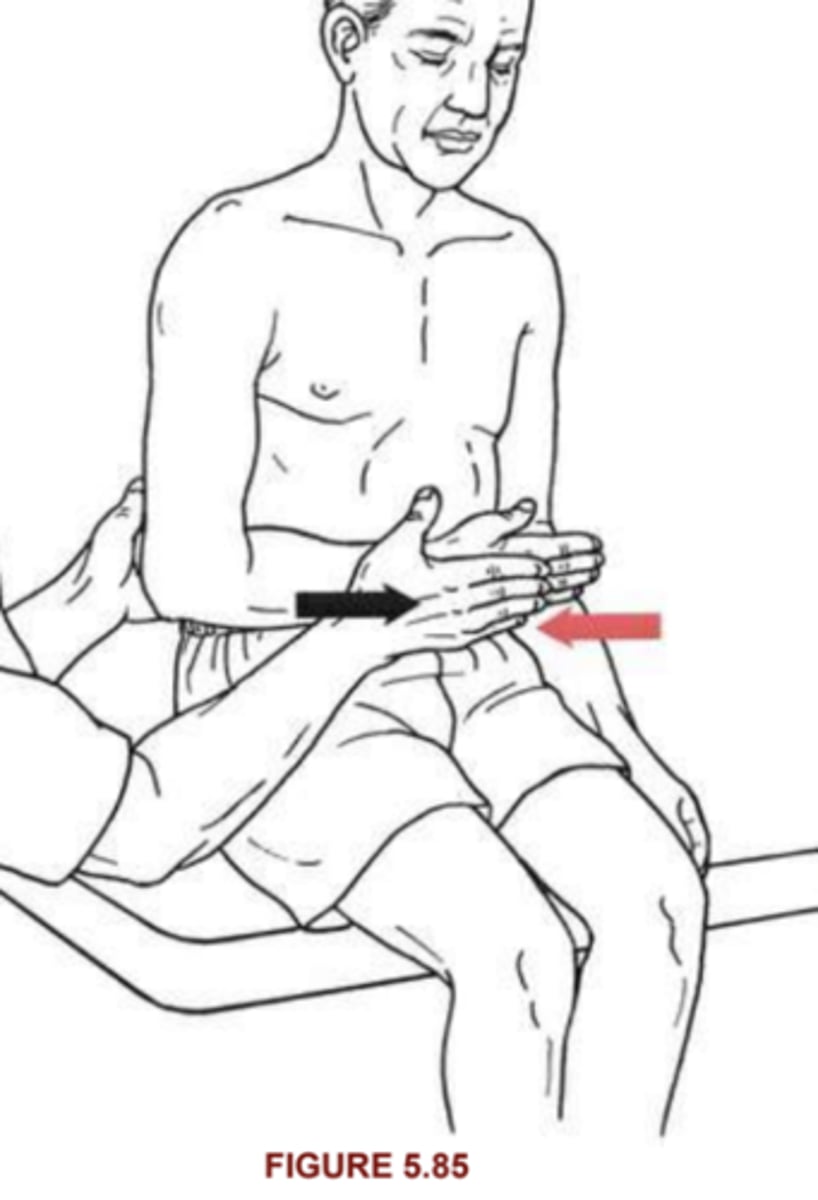
ROM: Gravity Minimized Shoulder External Rotation
Infraspinatus, teres minor, (supraspinatus, deltoid posterior)
Position: sitting, elbow flexed to 90, forearm in neutral, supported on table with friction minimized
2/5: completes rom in gravity eliminated position
1/5: palpation of either/both muscles show contraction
0/5: no palpable contraction
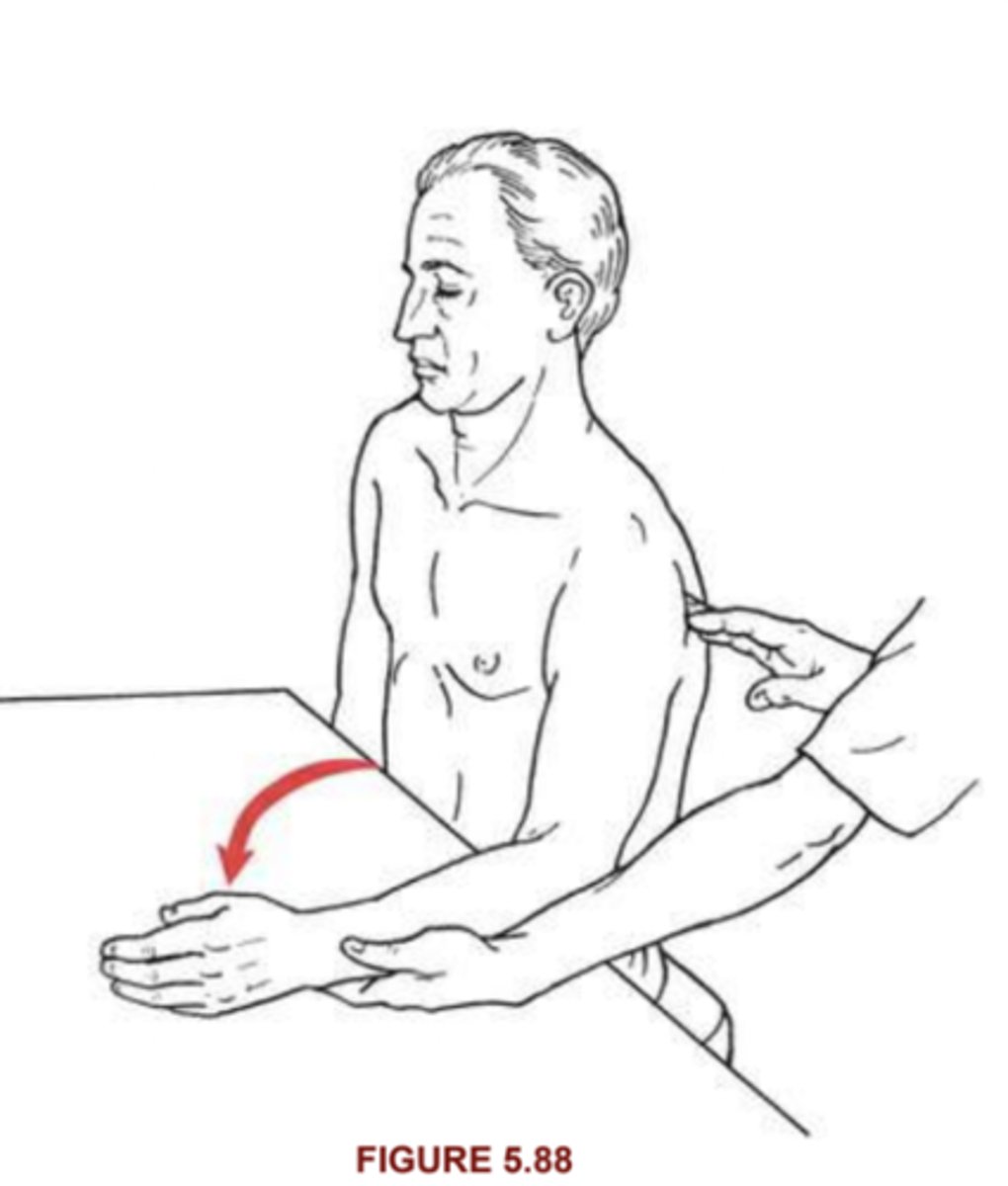
MMT: Shoulder Internal Rotation
Subscapularis, teres major, pec major (clav), lat dorsi
Position: sitting, with elbow flexed to 90, neutral hand,
Instruction: stand in front of pt and ask to pull forearm toward trunk
3/5: full rom
4/5: hold against strong resis, some yield is felt
5/5: hold against max resis
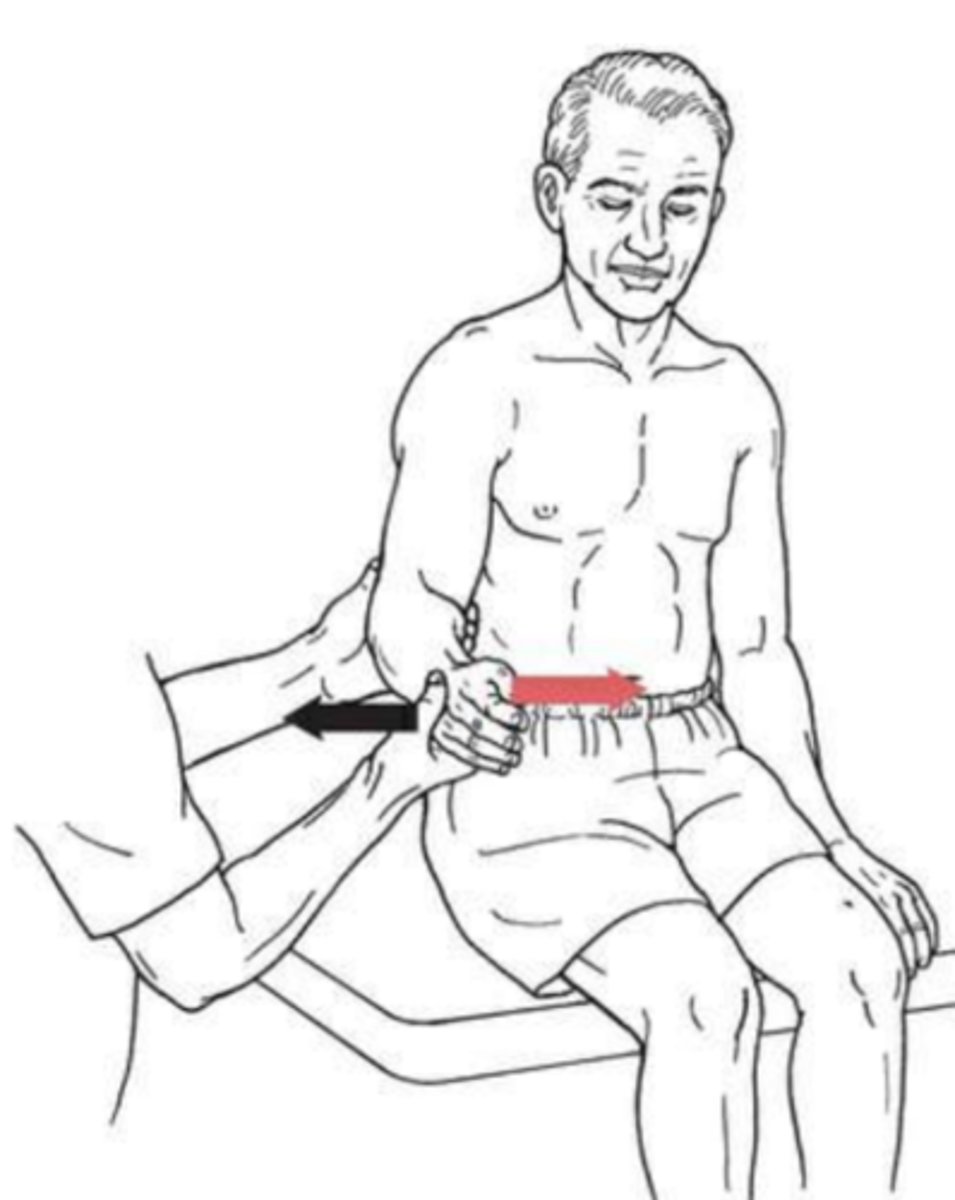
MMT: Gravity Minimized Shoulder Internal Rotation
Infraspinatus, teres minor, (supraspinatus, deltoid posterior)
Position:
Instruction:
2/5: not able to complete available rom
1/5: palpable contraction
0/5: no palpable contractile activity
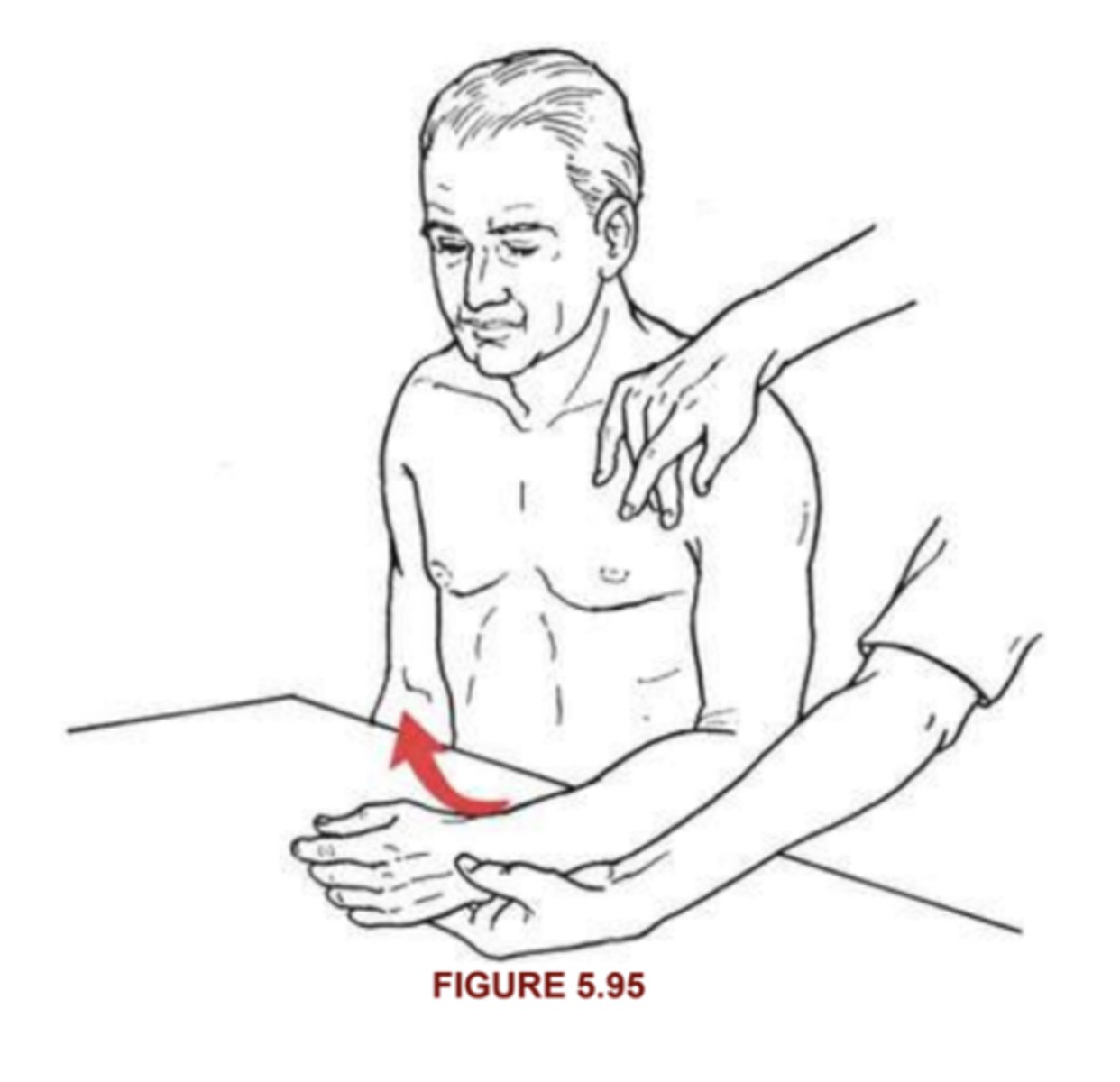
MMT: Scapular abduction/protraction and upward rotation
serratus manterior, pec minor (up/low trap)
Position: sitting, arm foward flexed 130 deg, protract in plane as far as it can go
Instruction: stand behind pt and get up on table, ask pt to protract arm (punch forward) assess rom, stabilize trunk below scap and distal humerus, look for winging of meidal border off rib cage
3/5: scapula goes thru full rom w/out winging, w/out resistance
4/5: scapular muscles "give" or "yield" against maximal resistance
5/5: scapula maintain abd and rotated against max resis
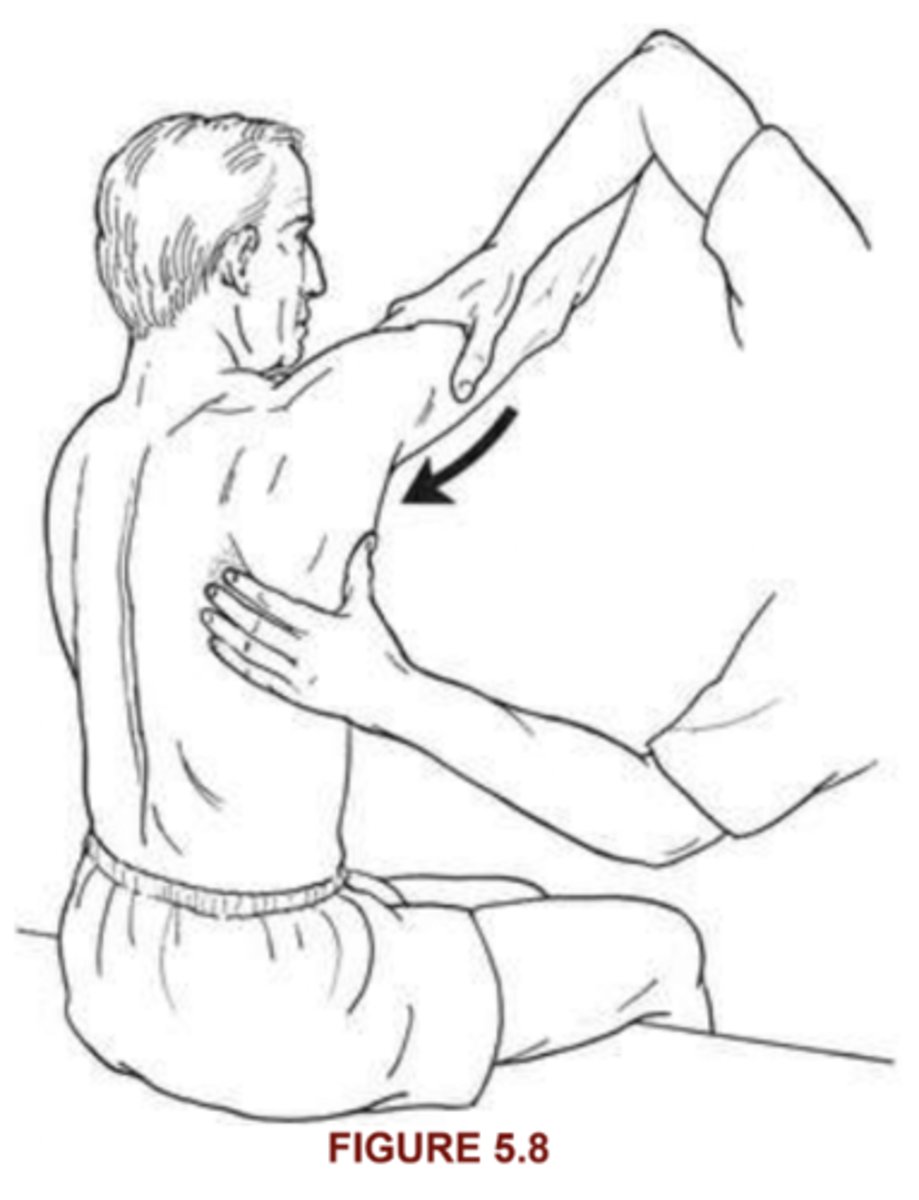
MMT: Gravity Minimized Scapular abduction w/ upward rotation
short sitting, arm flexed above 90, supported by PT
stand at side of pt, support arm below elbow, and on inferior angle of scap with thumb on axillary border
“Hold your arm in this position” (i.e., above 90°). “Let it relax. Now hold your arm up again. Let it relax.”
2/5: If the scapula abducts and rotates upward as the patient attempts to hold the arm in the elevated position, the weakness is in the G-H muscles. If the scapula does not smoothly abduct and upwardly rotate without the weight of the arm or if the scapula moves toward the vertebral spine, the weakness is in the serratus and should be graded a 2.
1/5: muscle contraction is palpable
0/5: no palpable contraction
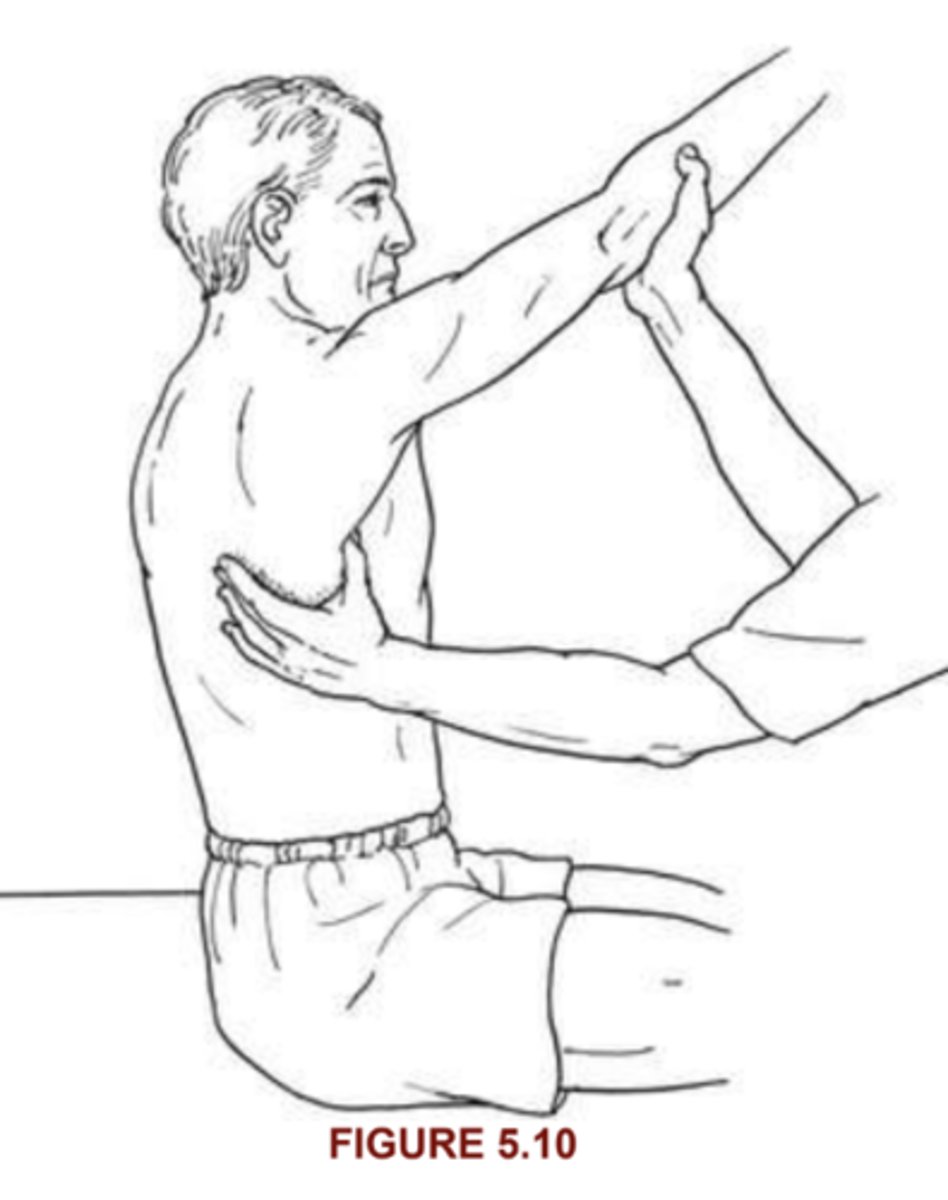
MMT: Shoulder/Scapular Elevation
Upper Trap, Levator Scap, rhomboid (M/m)
Position: sitting, PT pushes on shoulder
3/5: elevate through full rom w/out resistance
4/5: hold against strong to moderate resistance, may "give"
5/5: hold against max resistance
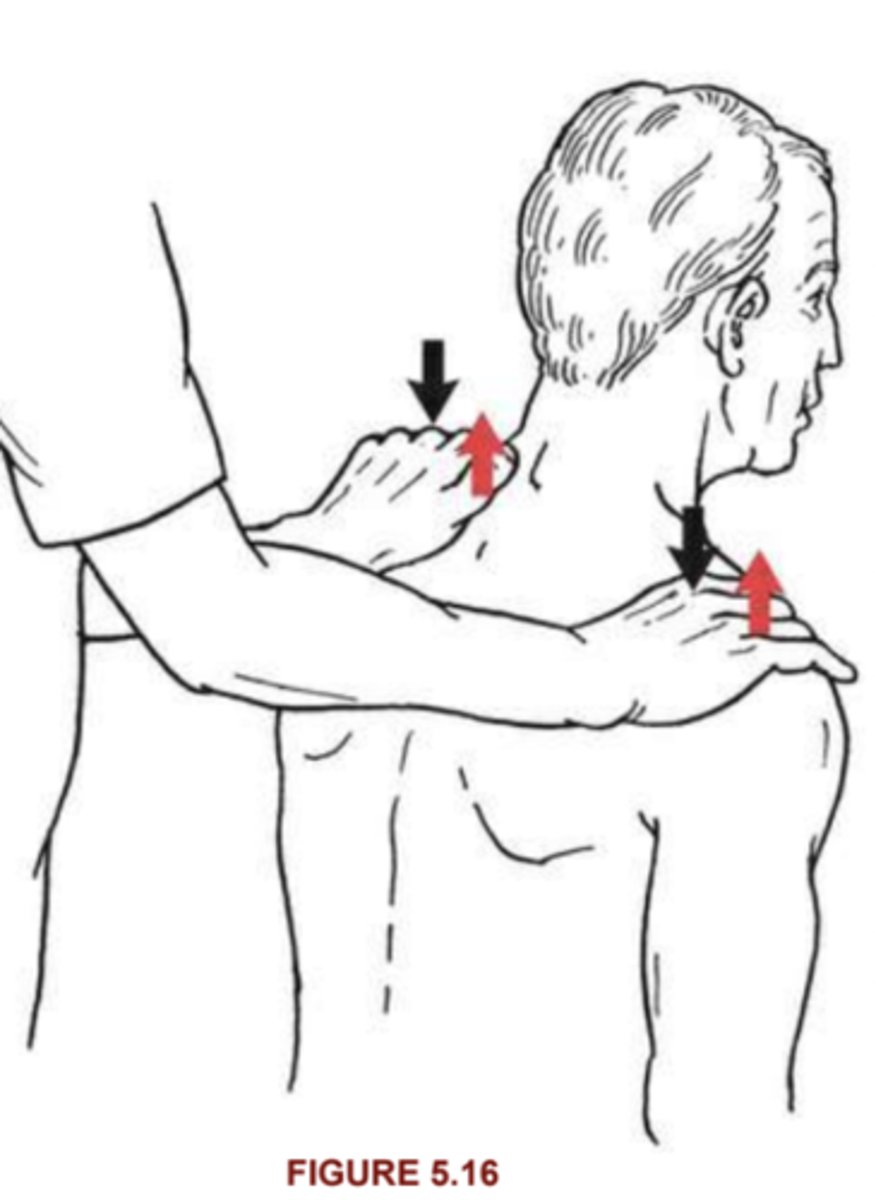
MMT: Gravity Minimized Shoulder/Scapular Elevation
Upper Trap, Levator Scap, rhomboid (M/m)
prone: head can be turned away, support test shoulder in palm of one hand, other palpate upper trap near insertion above clav
Instruction:
2/5: pt completes full rom in gravity-minimized
1/5: upper trap can be palpated at clavicle or neck, if felt
5/5: hold against max resistance
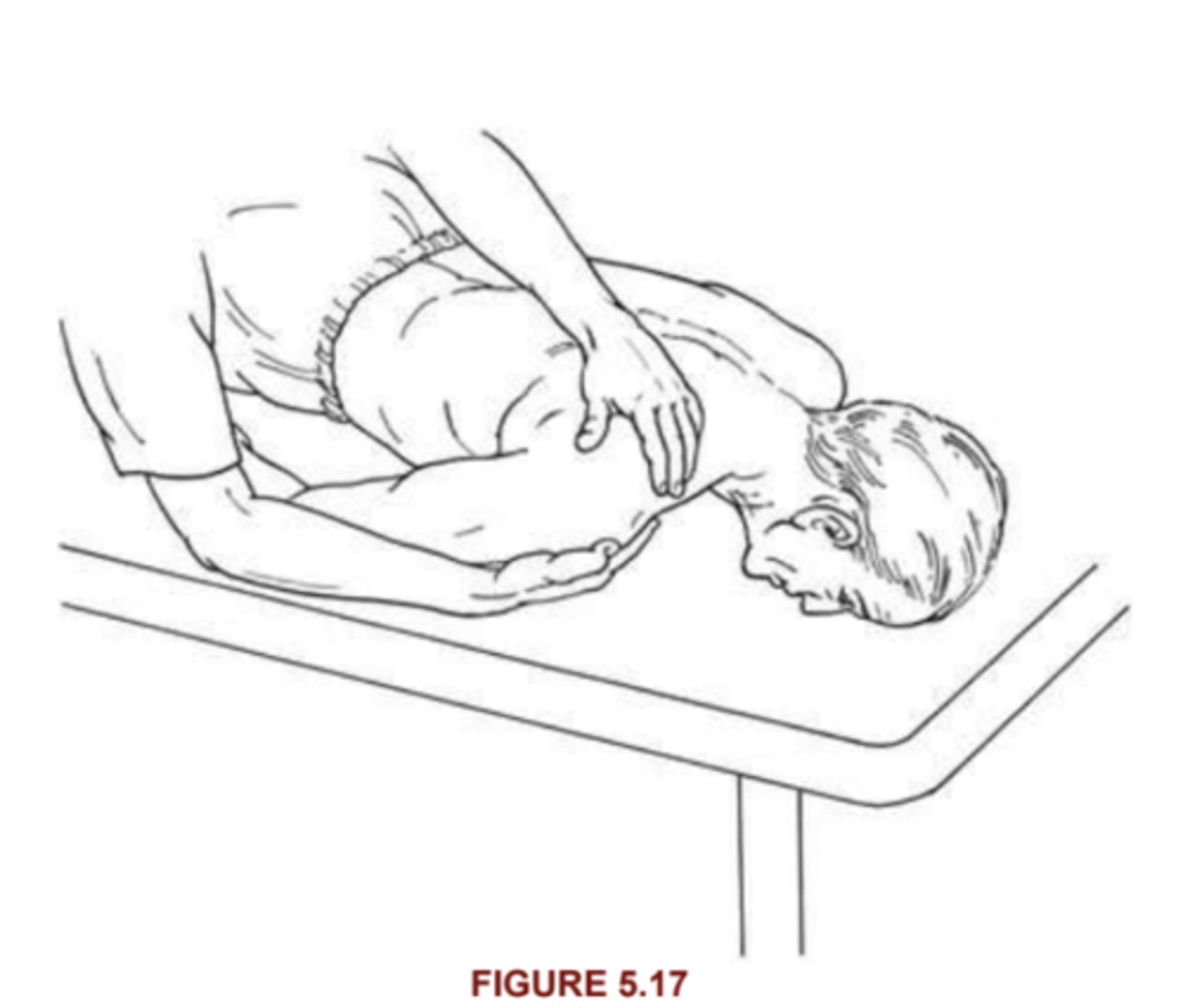
MMT: Scapular Adduction/ Retraction
Middle Trap, rhomboid major, (minor, upper/lower trap, lev scap)
Position: prone, shoulder at edge, abducted 90, elbow flexed w/forearm + hand hanging off table, head can be turned
Instruction: stand behind test arm, stabilize contralateral scapular area, push down on
3/5: complete available position
4/5: hold position against strong/mod resist.
5/5: hold position against max resis
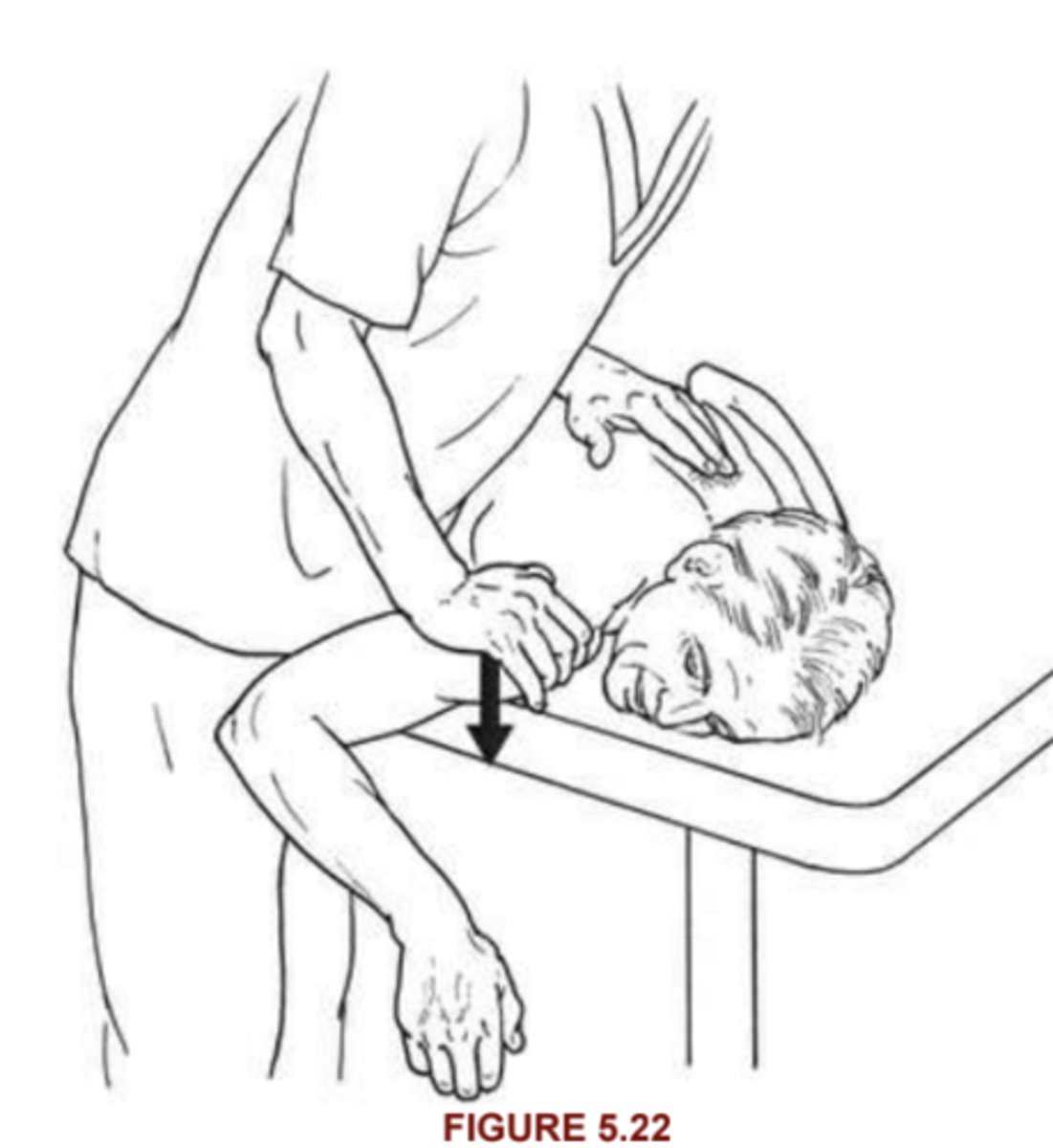
MMT: Gravity Minimized Scapular Adduction/ Retraction
serratus manterior, pec minor (up/low trap)
Position:
Instruction:
2/5:
1/5:
0/5:
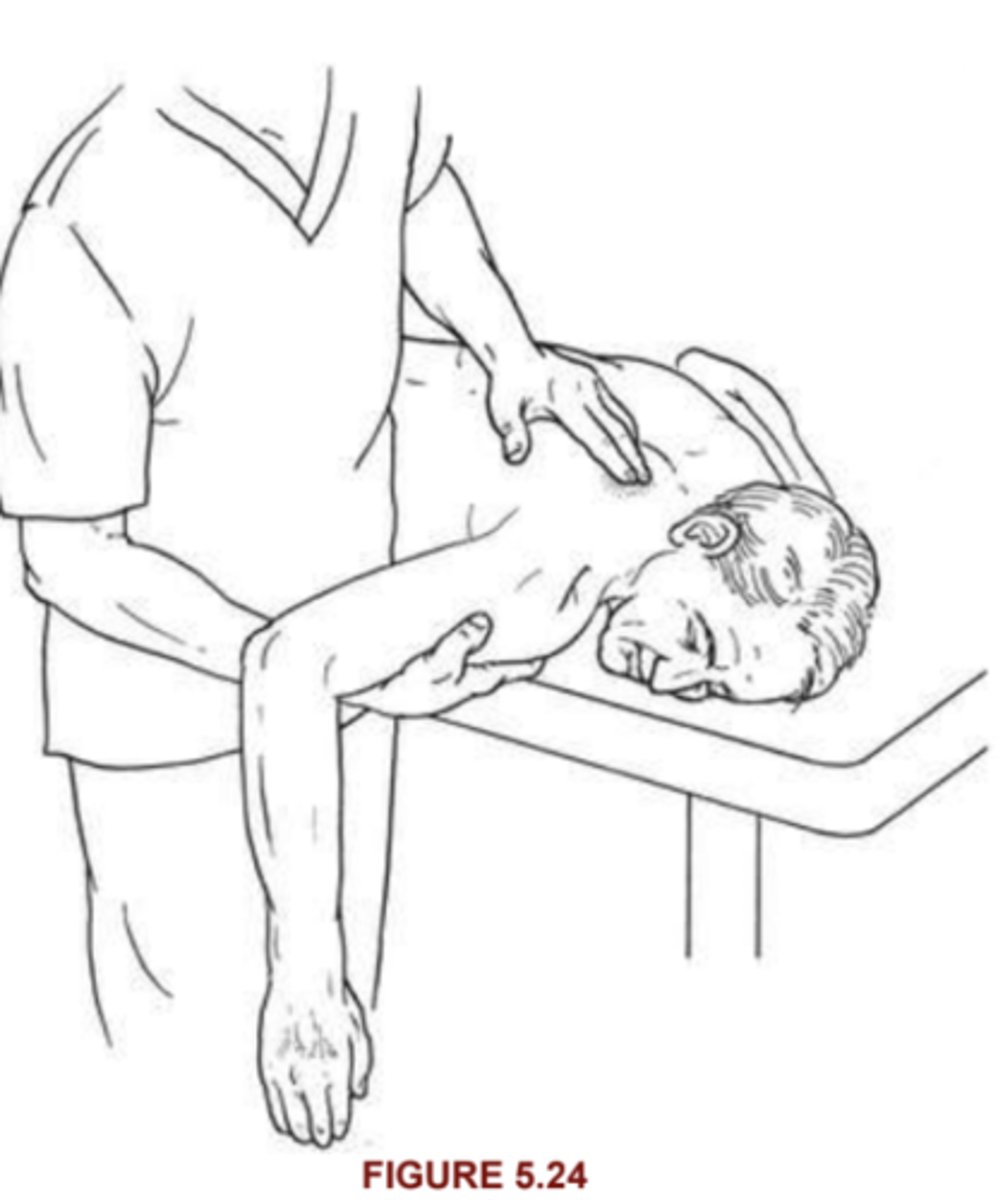
scapular depression and adduction
trap middle and lower, lat dorsi (pec M/m)
prone, test arm over head to 145 shoulder elevation, abduction, thumbs up, head to side
"lift arm off table past ear"
stand at test side. ask pt to raise arm from table as high as possible
stabilize under scap and push distal forearm (wrist)
4/5 over distal humerus or light resistance over forearm
5/5 over forearm
MMT: Gravity Minimized Shoulder Internal Rotation